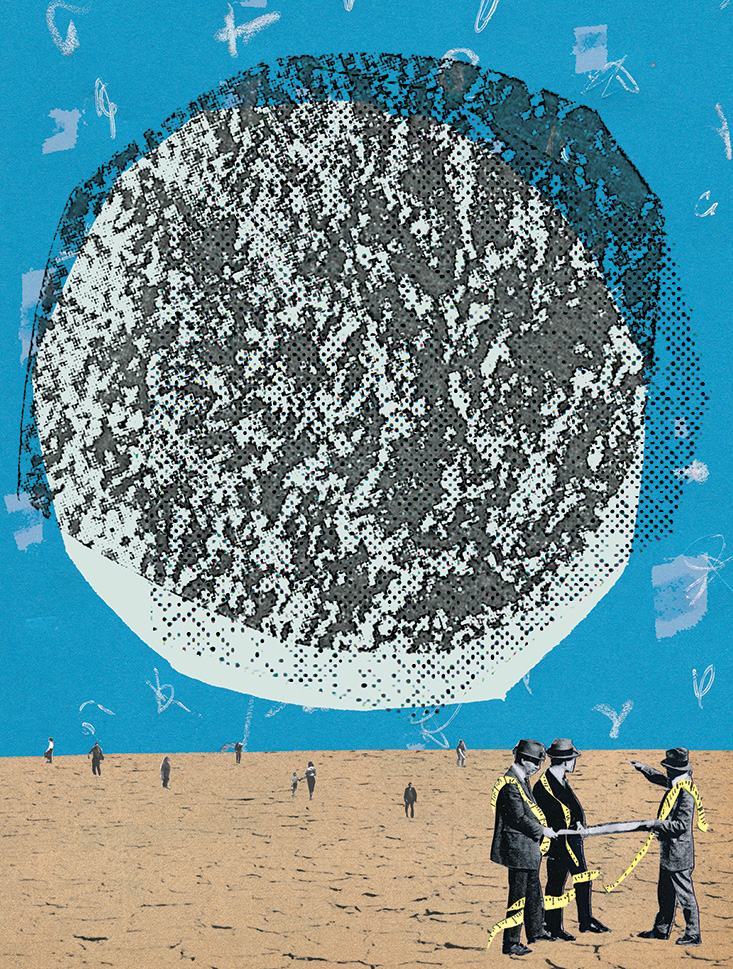What is this new theory?” the long-retired New York University cognitive psychologist, Lloyd Kaufman, asked me. We were sitting behind the wooden desk of his cozy home office. He had a stack of all his papers on the moon illusion, freshly printed, waiting for me on the adjacent futon. But I couldn’t think of a better way to start our discussion than to have him respond to the latest thesis claiming to explain what has gone, for thousands of years, unexplained: Why does the moon look bigger when it’s near the horizon?
He scooted closer to his iMac, tilted his head and began to read the MIT Technology Review article I had pulled up.1 I thought I’d have a few moments to appreciate, as he read, the view of New York City outside the 28th floor window of his Floral Park apartment, but within a half-minute he told me, “Well, it’s clearly wrong.”
It wasn’t even my theory, yet I felt astonished. It described two researchers—Joseph Antonides (an undergraduate) and Toshiro Kubota (a computer scientist), of Susquehanna University in Pennsylvania—who had constructed a perceptual model in which the sky was contiguous with the horizon, so that the moon was placed, as it were, in front of the sky, occluding it.2 Since our depth perception also places the moon farther away from us than the horizon, we are faced with a perceptual dilemma. The scientists reasoned that the horizon moon’s enlargement is a product of the brain trying to solve this dilemma.
It’s wrong, he told me, because “you can get the illusion if you have only one eye. Simple!”
The moon illusion is a sort of Rip Van Winkle figure in the history of science. Unlike other astronomical puzzles, the moon illusion, wrote Rutgers University philosopher Frances Egan, “has persisted through massive changes both in our overall physical theory, and in our very conception of the scientific enterprise.”3
The earliest mention of the moon illusion we know of was impressed almost 3,000 years ago, in cuneiform script upon a clay tablet, when it was housed in the royal library of Nineveh.4 Later on, in the second century A.D., Ptolemy argued that it was the result of the magnifying properties of the atmosphere’s moisture and haze. “It is just like the apparent enlargement of objects in water, which increases with the depth of immersion,” he wrote.5 On account of something like divine authority, this physical or “refraction” account of the problem went unchallenged for more or less 1,000 years, a real shame since he also had an alternative physiological account that went largely ignored until Newton’s time.6

Today, this physiological account is known as the “angle-of-regard” hypothesis, for the angle that our eyes (or head) make relative to the horizon. The more your eyes are angled upward, the thinking goes, the smaller something looks, due to the physiology of our visual system. Angle-of-regard sat dormant for hundreds of years after Ptolemy, until the Irish philosopher George Berkeley revived it, in 1709, as part of a debate with the then-new geometrical optics of philosophers like René Descartes and Nicolas Malebranche.
They took the moon illusion to support their contention that vision is inherently three-dimensional, and that we can compute size and distance using vision alone. In his “Essay Towards a New Theory of Vision,” Berkeley opposed this view, pointing out that the moon illusion could be explained away using the angle-of-regard hypothesis; and claiming that there is nothing inherently three-dimensional about what we see—that instead we learn about how far and how big things are by moving around in the world, hands-on, as it were. Descartes, though, didn’t accept the angle-of-regard dismissal of the moon illusion. Instead he held to the “apparent distance” hypothesis, according to which the horizon moon seemed larger because we judged it to be farther away.
“It’s the challenge of solving a problem the likes of Galileo and Newton couldn’t handle.”
Neither hypothesis was generally accepted until the 1940s, when angle-of-regard was made briefly triumphant by the work of Harvard psychologist Edwin G. Boring. That was before Kaufman arrived on the scene in 1956, in search of a thesis topic for his masters in psychology. When I asked Kaufman why, out of all the unsolved mysteries in science, he chose to dedicate his attentions to this one, he offered his reason as if it ought to have been obvious. “It’s the challenge of solving a problem the likes of Galileo and Newton couldn’t handle.”
In their 1962 paper, Kaufman and his colleague Irvin Rock attacked angle-of-regard. They pointed out, in a section ominously titled “Grounds for Caution,” that if you looked at the horizon moon with your chin tucked in and your eyes elevated, the moon illusion persisted—regardless. They also criticized Boring’s experimental methodology and his evaluation of Descartes’ apparent distance hypothesis.
In pursuit of a new explanation, Kaufman and Rock performed a set of experiments using a device that could place a disk of light in the sky so that it was “exactly like looking through a window at the moon.”7 They considered eye-elevation both outdoors and indoors, the moon’s color and brightness, and the presence of terrain. The first two had no effect, but the third was crucial: They concluded that if an observer’s view of the terrain is obstructed, the illusion vanishes.
This observation supported the apparent distance hypothesis: The presence of terrain increased the subjective sense of distance to the moon, so that while it was actually the same size, the perceptual system would “conclude” that it was a more distant object and thus inflate its size. Boring had rejected the apparent distance hypothesis because people reported that the horizon moon looks closer, not farther away. As the behavioral physiologist J.T. Enright points out, this size-distance paradox seemed to require some kind of disconnect between our conscious and subconscious perception of distance: We expand the moon to be larger given that it seems farther away, but then report that it seems closer. “The subconscious impression of distance, once it has determined apparent size, must remain irretrievably locked in the subconscious,” he wrote. “These seem to be unresolvable paradoxes.”

But Kaufman’s data clearly pointed to the importance of terrain, as did other experiments.8 Kaufman even called the astronaut Ed Lu when he was overhead in the International Space Station to ask him if he saw the moon illusion up in space: He said no. “There’s nothing there but the curvature of the Earth,” Kaufman told me. “You got no distance.” Plus, he told me, he’s asked test pilots (“these guys have eyes like eagles”) if they see the moon illusion. They told him “sure, but only when we get down low.”
In a 2007 paper, Kaufman confronted the “size-distance paradox” head-on.9 The traditional description of the paradox involves three consecutive acts of perception: First, we perceive the moon to be farther away because of terrain, then we perceive it to be larger because it is farther away, and then we perceive it to be closer because it is larger. But, Kaufman says, “perceptions do not cause perceptions.” One or more of the steps in this causal chain might involve a conscious judgment rather than a subconscious perception, or might result from a complex simultaneous network of connections and inferences of which we are unaware. We need to remember, says Kaufman, that “perceptions are outcomes of computational processes far more numerous and complicated than the perceptions themselves.” Judgment and perception might be correlated with each other, but they do not cause one another.
Clearly spelling out the error is hard, he told me, because “it’s not intuitive.” He said, “When I try to make it explicit, I run into a lot of difficulty, and that’s why I’m hung up on this last paper I’m doing.” Precisely explaining the mechanics of our vision is a problem Kaufman shares with some august company: It was Kepler who wrote four centuries earlier that, “perception does not belong to optics but to the study of the wonderful.”10
Brian Gallagher is an editorial intern at Nautilus. He has written for Mic and the Santa Barbara Independent. @brianscottg
References
1. Moon illusion: New theory reignites debate over why moon appears larger near the horizon. MIT Technology Review http://www.technologyreview.com (2013).
2. Antonides, J. & Kubota, T. Binocular disparity as an explanation for the moon illusion. Preprint arXiv 1301.2715 (2013).
3. Egan, F. The moon illusion. Philosophy of Science 65, 604-623 (1998).
4. Plug, C. & Ross, H.E. Historical review. In Hershenson, M. (ed.) The Moon Illusion Psychology Press, New York, NY (1989).
5. Ross, H.E. & Ross, G.M. Did Ptolemy understand the moon illusion? Perception 5, 377-385 (1976).
6. Enright, J.T. The moon illusion examined from a new point of view. Proceedings of the American Philosophical Society 119, 87-107 (1975).
7. Osmundsen, J.A. Modern psychology upholds Ptolemy on moon illusion; Ptolemy upheld on explantion of why horizon moon is ‘larger.’ The New York Times (1960).
8. Hamilton, J.E. Effect of observer elevation on the moon illusion. American Journal of Optometry and Archives of American Academy of Optometry 42, 417-431 (1965).
9. Kaufman, L. et al. Perceptual distance and the moon illusion. Spatial Vision 20, 155-175 (2007).
10. Fishman, R.S. Kepler’s discovery of the retinal image. Archives of Ophthalmology 89, 59-61 (1973).
*As originally published, this caption stated that the moon was rising. It is, in fact, setting.























